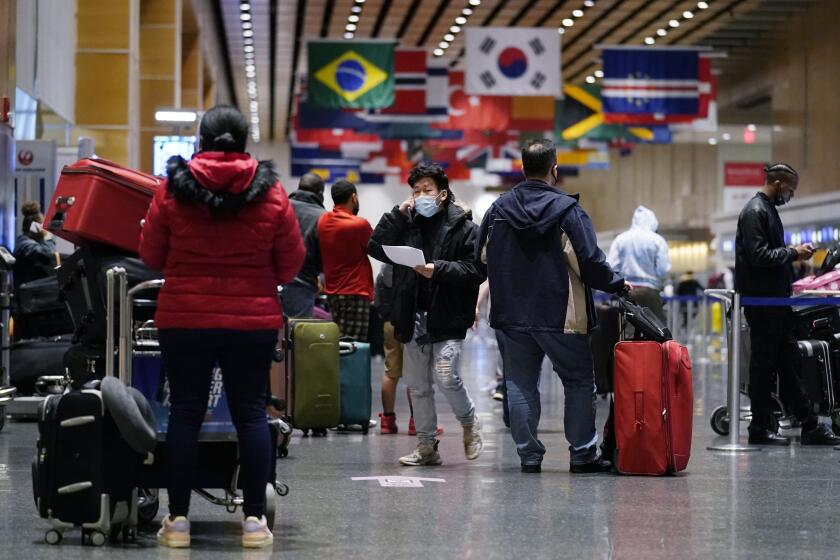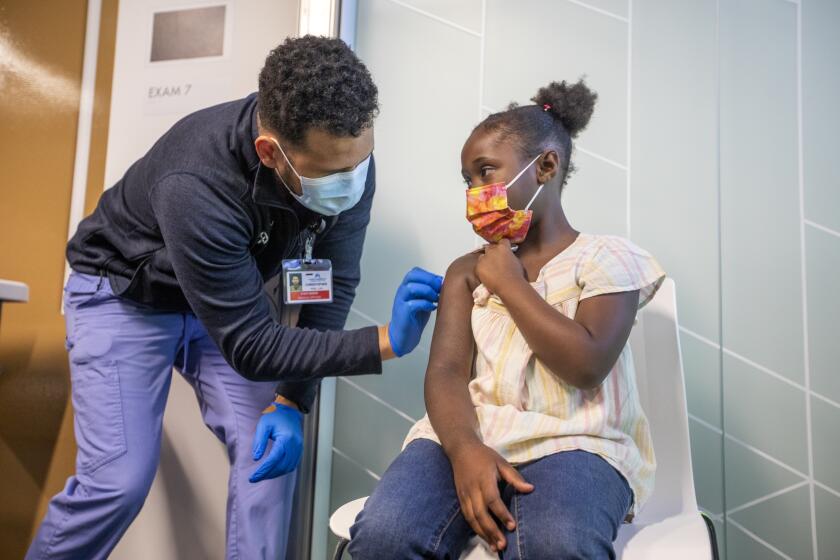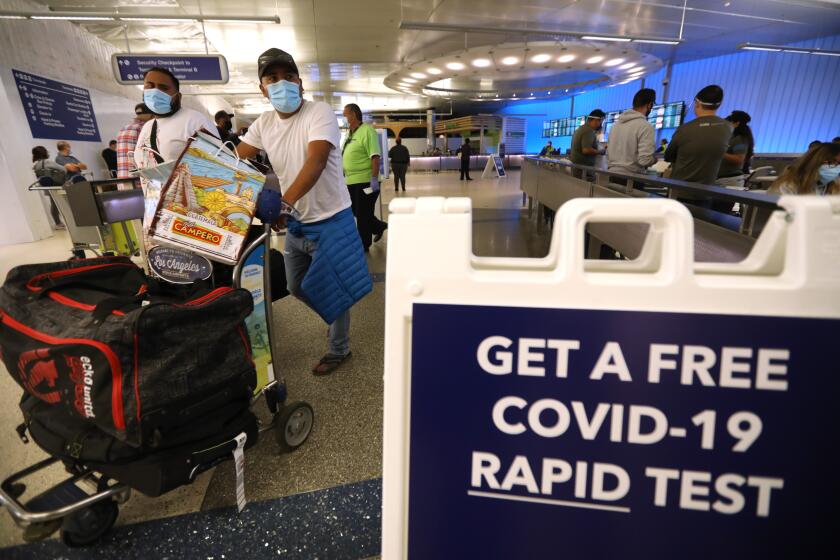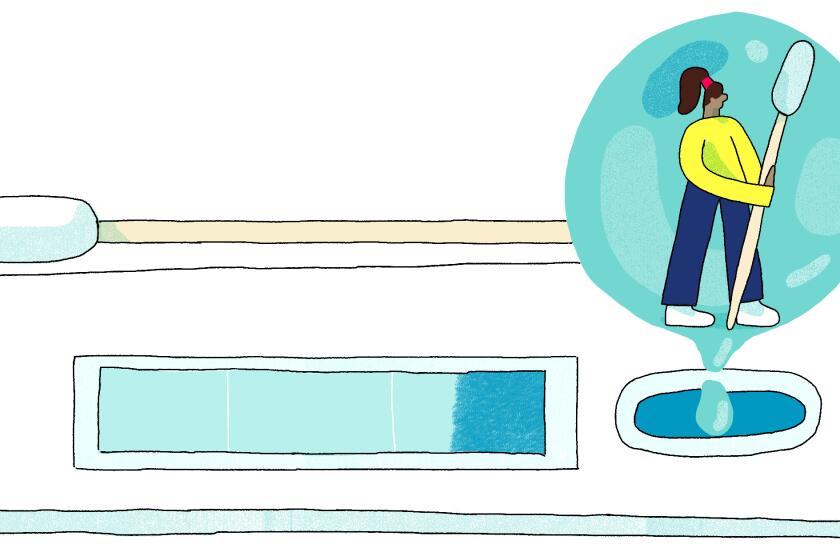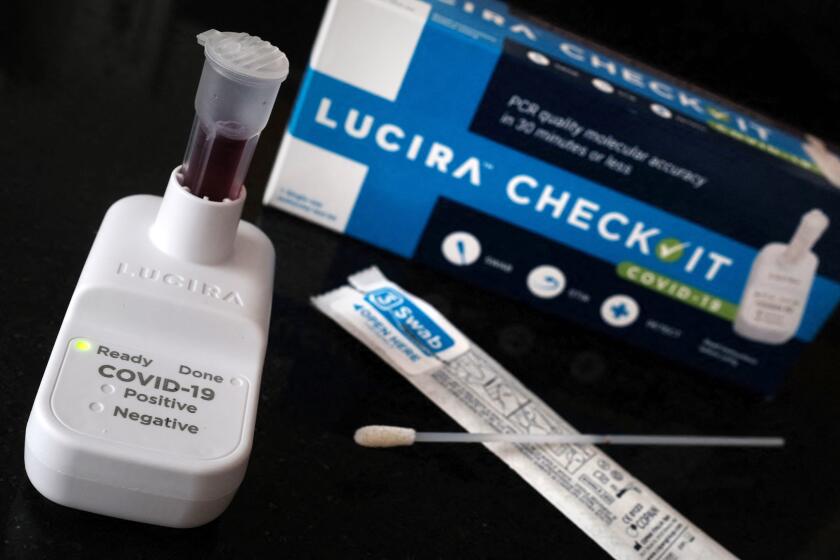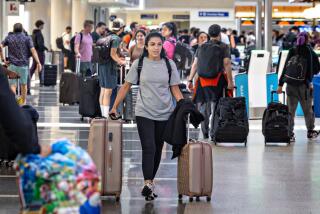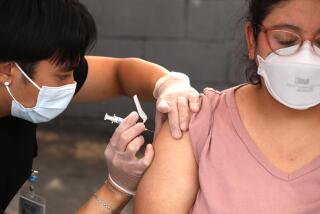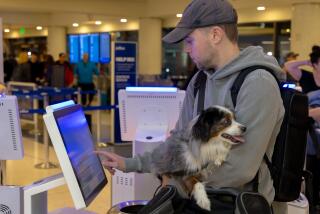Flying over the holidays? Here are tips for reducing your Omicron risk
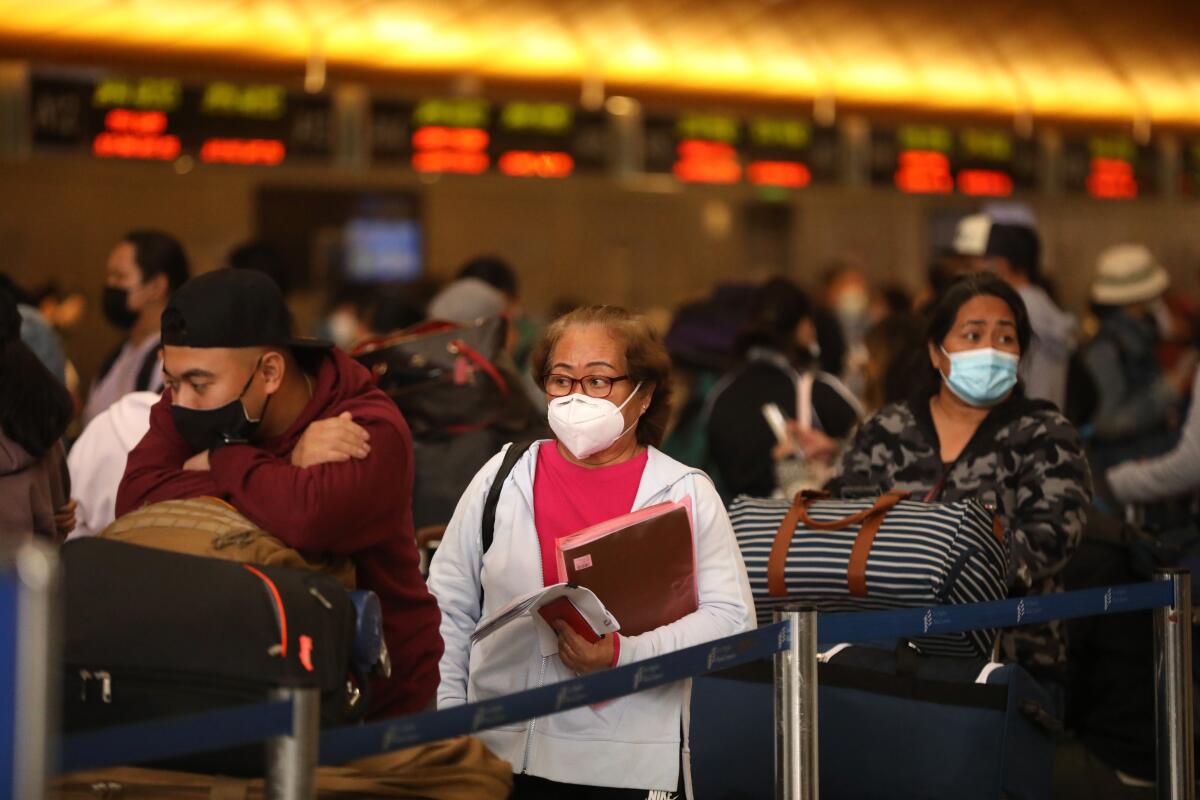
- Share via
Los Angeles International Airport expects 3.5 million people to pass through its gates this holiday season, with as many as 200,000 people a day on peak travel dates.
And with no vaccination or testing requirements for domestic air travel in the United States, the Omicron variant is likely to be racking up frequent-flier miles as well.
Airlines canceled hundreds of flights as the omicron variant jumbled schedules and drew down staffing levels at some carriers during the busy holiday travel season.
Before vaccines were available, the guidance for flying was generally “don’t, unless you absolutely have to.” With vaccines now widely accessible to people ages 5 and older, that’s changed. Dr. Anthony Fauci, President Biden’s chief medical advisor, told NBC that his children are all boarding flights in the near future.
But not everyone is packing their bags just yet. With the Omicron variant poised to pummel Los Angeles and other population centers, people may be mulling whether they need to cancel their plans entirely. The grim truth is that there is no way to eliminate the risk of catching COVID-19 if you are going into a crowded indoor space like an airport. But there are ways to lower your risk.
If you are flying this week, here’s how to do it as safely as possible.
Prepare for big spikes in COVID-19 hospitalizations and deaths in areas with low vaccination rates, experts say.
Before your trip
The best and most effective way to protect yourself is to be fully vaccinated, including a booster shot.
“I actually think you’d be crazy and immoral to fly if you are not vaccinated,” said Paula Cannon, a virology professor at the USC Keck School of Medicine. “Ideally boosted but certainly vaccinated.”
Even if you get the booster only a couple of days before your flight, you’ll have some degree of extra protection.
“Anything’s better than nothing,” Cannon said.
If you can get a COVID test before you travel, you should. Omicron seems to cause milder symptoms than previous variants of COVID-19, particularly in fully vaccinated people. You could have it and not know it. (It should go without saying, but: If your test comes back positive, you should not travel, even if you feel totally fine.)
LAX currently offers on-site rapid antigen and PCR (molecular) testing, but they’re not cheap: $125 for a nasal swab PCR test with results in three to five hours, one-hour rapid tests for $199 and one-hour antigen tests at the Tom Bradley International Terminal for $80. Testing must be booked ahead of time online. Alternately, you can find a testing site online or check your local pharmacy or big-box retailer and see if they have rapid tests available for purchase. PCR tests are generally considered more accurate in detecting infections in asymptomatic people.
As with all these prevention measures, testing creates another layer of protection for you and your loved ones. Speaking of layers: Up your mask game. At this point, we know single-layer cloth masks don’t offer the same protection as KN95s and N95s. Get your hands on one of those types of masks to use during your trip and make sure to wear it properly. There’s also evidence that glasses, goggles or face shields provide some extra bit of protection, though we don’t know how much. If you can wear glasses or bring a face shield, you might as well.
The airport expects nearly twice as many travelers as last year, reflecting a “cautious optimism” around the pandemic
At the airport
At the start of the pandemic, the guidance was to maintain six feet of distance from other people. With Omicron’s elevated transmissibility, six feet might not be enough. And in an airport with holiday crowds, even getting a foot or two of personal space in the security or boarding line can be difficult. Once again, it’s about doing your best and accepting that there is going to be some risk.
“Rather than have [six feet of distance] as a hard, fast rule, have that as an ideal situation,” Cannon said. “If there’s not many people in the coffee line, I would stand back. I wouldn’t be right up against somebody. But if I’m on the jet bridge, I’m not going to be freaking out, going, ‘Everybody needs to move away from me.’ I would just accept the risk that’s inherent in going into a crowded place.”
If you can sit in a less crowded area while you wait for your flight, do that. If you can wait and be the last person to board to avoid cramming into the unventilated jetway, do that.
On your flight
Airlines allow people to remove their masks while they eat and drink. You are the most at risk when the people around you are unmasked, so if you want to enjoy a drink or in-flight snack, wait until the people around you are done eating. If at all possible, avoid eating and drinking entirely. If you absolutely need to take a sip of something, poke a straw under your KN95 or N95 mask.
The air on the plane is circulated through a powerful High Efficiency Particulate Air filter. The cleanest air comes out of the nozzle above you. Cannon recommends pointing it at yourself and cranking it to full blast for the duration of the flight, creating a cone of freshly filtered air that will keep your seatmate’s germs away. (In case it’s been a while since your last flight: That air comes out cold. Bring a jacket.)
One protective measure you don’t have to take: Sanitizing your tray table or seat arms. Washing your hands as frequently as possible and avoiding touching your face is just good public health common sense, especially in wintertime, but you’re unlikely to catch COVID-19 from the buttons on your seat-back entertainment center, Cannon said.
“It’s become increasingly clear that the dominant way this virus is transmitted is [when] you breathe it in,” she said.
Add some rapid COVID-19 tests to your holiday shopping list. Once you’ve got them, here’s what you should know about how, when and why to use them ahead of Thanksgiving, Hanukkah, Christmas or other holiday gatherings.
After you land
Plan to test, and test again. Cannon said that if she were traveling, she would do a test as soon as she landed, then another one to two days later. If you are hosting family or other guests this holiday season, have a home test ready along with a hot cup of cocoa when they arrive.
The Centers for Disease Control and Prevention recommends that unvaccinated travelers quarantine for seven to 10 days after returning from a trip, but post-travel isolation of any kind for vaccinated people is not recommended. In the U.K., fully vaccinated travelers need to take a PCR test within two days of arriving and self-isolate at their destination until they get a negative result, which is not mandatory in the U.S. but is thoughtful guidance to keep in mind if you’d like to be even more cautious about not infecting your relatives.
There are hundreds of testing sites across Southern California, and rapid test kits can be bought at pharmacies or ordered online.
This is a lot. Should I just cancel my plans?
It has been a hard year, on the heels of a hard year. Experts understand the importance of seeing family and celebrating the holidays, especially after so many of us spent the last ones alone. At the same time, Omicron seems scarier by the day.
When I asked Cannon whether she was available to speak for this article, she said she was — because she had just canceled plans to visit family in London. She said that over the weekend, at least half a dozen people had called to ask her about doing the same thing. Her advice was this: You cannot make your COVID risk zero if you are traveling. If any level of risk is going to make your holidays feel like a stressful nightmare, don’t go.
“If you’re going to be super anxious and miserable and not enjoy Christmas ... I think that’s actually an extremely valid reason to cancel your trip and say, ‘You know what, no one saw Omicron coming, it’s lousy timing. This wave will pass. And we’ll come visit in the spring when we’re over this.’”
If you decide to stick to your plans, get your hands on some tests and good masks, eat before you leave for the airport, and try to maintain as much personal bubble as possible. Conversely, if you need someone’s permission to cancel Christmas at grandma’s, you have it.
More to Read
Sign up for The Wild
We’ll help you find the best places to hike, bike and run, as well as the perfect silent spots for meditation and yoga.
You may occasionally receive promotional content from the Los Angeles Times.
